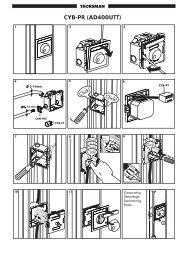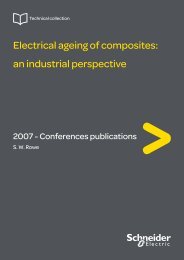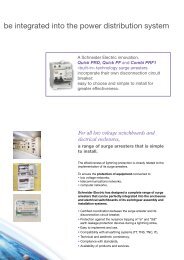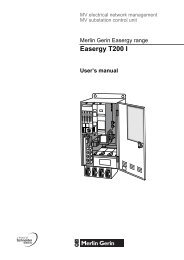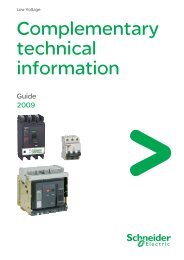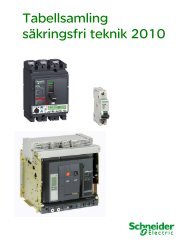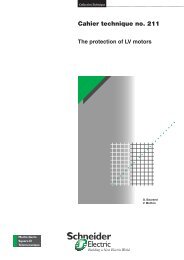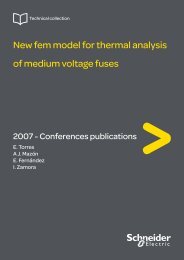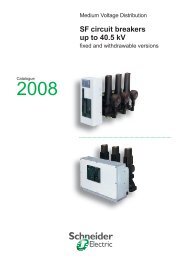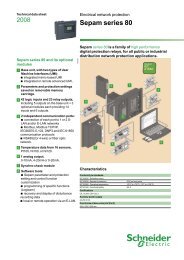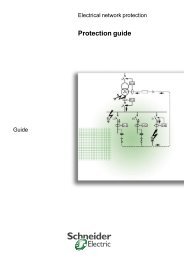Load control to balance limited or intermittent ... - Schneider Electric
Load control to balance limited or intermittent ... - Schneider Electric
Load control to balance limited or intermittent ... - Schneider Electric
Create successful ePaper yourself
Turn your PDF publications into a flip-book with our unique Google optimized e-Paper software.
<strong>Schneider</strong> <strong>Electric</strong> 2007 - Conferences publications<br />
C I R E D <br />
<br />
<br />
<br />
netw<strong>or</strong>k conditions. These loads could be associated with<br />
s<strong>to</strong>rage systems f<strong>or</strong> a better efficiency [1].<br />
Lighting loads: Surveys in the tertiary sec<strong>to</strong>r showed that<br />
decreasing light by approximately 30% in buildings does<br />
not harm visual comf<strong>or</strong>t of the employees [5].<br />
Others equipments: These loads are composed of television,<br />
audio systems, and computers. Generally, these equipments<br />
are not <strong>control</strong>lable, except some computer applications,<br />
equipped with inverters.<br />
Thermal loads seem <strong>to</strong> represent the most promising<br />
applications concerning load <strong>control</strong>. The thermal inertia of<br />
these loads would enable <strong>to</strong> cut <strong>or</strong> <strong>to</strong> decrease the<br />
alimentation of these applications. These loads are already<br />
used in some DSM programs. Nevertheless some<br />
parameters must be respected such as cus<strong>to</strong>mer comf<strong>or</strong>t, <strong>or</strong><br />
standards. M<strong>or</strong>eover, as their prop<strong>or</strong>tion in residential and<br />
tertiary sec<strong>to</strong>rs is significant, they would allow a possible<br />
contribution <strong>to</strong> Ancillary Services if users could be<br />
sensitized on their energy consumption.<br />
Potential f<strong>or</strong> a m<strong>or</strong>e optimal <strong>control</strong> scheme seems <strong>to</strong> exist<br />
in industrial, commercial, and tertiary sec<strong>to</strong>rs because loads<br />
in these sec<strong>to</strong>rs have a high amount of power. In the<br />
industrial sec<strong>to</strong>r, possibilities are different depending on the<br />
application and the process. In tertiary and commercial<br />
sec<strong>to</strong>rs, a potential f<strong>or</strong> increased <strong>control</strong>lability exists<br />
especially with lighting loads, where decreasing light level<br />
would not alter users’ comf<strong>or</strong>t.<br />
Finally, concerning the residential sec<strong>to</strong>r and its associated<br />
small loads (electrical goods, lighting loads) the actions <strong>to</strong><br />
be taken are linked <strong>to</strong> energy management. It is always<br />
better <strong>to</strong> consume less, but it would be m<strong>or</strong>e efficient <strong>to</strong> use<br />
energy in a m<strong>or</strong>e efficient way.<br />
<strong>Load</strong> Models<br />
To develop load <strong>control</strong> alg<strong>or</strong>ithms, models are required <strong>to</strong><br />
describe the different loads. Depending on the aim of the<br />
<strong>control</strong>, and the amount of loads, various models can be<br />
used. Because of the large diversity and distribution of<br />
loads, a single model is hard <strong>to</strong> establish, and different<br />
models have been proposed <strong>to</strong> achieve various <strong>control</strong><br />
criteria. Acc<strong>or</strong>ding <strong>to</strong> this aim, a classification appears<br />
between static and dynamic models. The first one links<br />
active/reactive power <strong>to</strong> frequency/voltage without time<br />
dependence, whereas the second one takes in<strong>to</strong><br />
consideration frequency/ voltage as a function of time.<br />
Static models<br />
A basic relation f<strong>or</strong> static models is the ZIP model,<br />
described by equations (1). Equations are divided in three<br />
terms containing constant power, constant current and<br />
constant impedance.<br />
2<br />
2<br />
⎡ ⎛ V ⎞ ⎛ V ⎞ ⎤ ⎡ ⎛ V ⎞ ⎛ V ⎞ ⎤<br />
P = P<br />
⎢<br />
⎟ ⎥<br />
0<br />
⋅ ⎢a<br />
⎜<br />
1<br />
⋅⎜<br />
⎟ ⎜ ⎟ ⎥<br />
⎜ ⎟<br />
2<br />
3<br />
=<br />
0<br />
⋅<br />
4<br />
⋅ +<br />
5<br />
⋅ +<br />
6<br />
⎢<br />
+ a ⋅<br />
+ a Q Q a<br />
0<br />
0 ⎥ ⎢<br />
a<br />
a<br />
0<br />
0<br />
⎣ ⎝V<br />
⎠ ⎝V<br />
⎠ ⎦ ⎣ ⎝V<br />
⎠ ⎝V<br />
⎠ ⎥<br />
⎦<br />
V 0 , P 0 , Q 0 are initial conditions values, and coefficients a 1 <strong>to</strong><br />
a 6 are the model parameters.<br />
Another static model, described in relations (2), is the<br />
( 1)<br />
exponential model, where power is voltage dependant.<br />
⎛ V ⎞<br />
P = P ⎟<br />
0<br />
⋅ ⎜<br />
V<br />
⎝ 0 ⎠<br />
np<br />
⎛ V ⎞<br />
Q = Q ⎟<br />
0<br />
⋅ ⎜<br />
V<br />
⎝ 0 ⎠<br />
P 0 , and Q 0 are initial power values; np and nq, are models<br />
parameters. Table 1 presents usual values f<strong>or</strong> the exponents<br />
of (2) f<strong>or</strong> different loads [6].<br />
loads np nq<br />
Air conditioning 0.5 2.5<br />
<strong>Electric</strong>al Convection Heater 2 0<br />
Flu<strong>or</strong>escent lamp 1 3<br />
Pumps, fans, little mo<strong>to</strong>rs 0.08 1.6<br />
Large industrial mo<strong>to</strong>rs 0.05 0.5<br />
Little industrial mo<strong>to</strong>rs 0.1 0.6<br />
Table 1<br />
Dynamic models<br />
To describe dynamic behaviour of loads, differential<br />
equations have been developed.<br />
One example is a load model with exponential covering,<br />
where active and reactive powers have a non linear relation<br />
with voltage. Equations (3) describe the model:<br />
αs<br />
dP ⎛<br />
r<br />
V ⎞<br />
Tp<br />
⋅ + Pr<br />
= P ⎟<br />
0<br />
⋅ ⎜<br />
dt<br />
V<br />
⎝ 0 ⎠<br />
αt<br />
⎛ V ⎞<br />
− P ⎟<br />
0<br />
⋅ ⎜<br />
V<br />
⎝ 0 ⎠<br />
nq<br />
( 2)<br />
⎛ V ⎞<br />
Pl<br />
= Pr<br />
+ P ⎟<br />
0<br />
⋅ ⎜<br />
V<br />
⎝ 0 ⎠<br />
V 0 and P 0 are voltage and power bef<strong>or</strong>e voltage variation; P r<br />
is the covering active power, P l is the <strong>to</strong>tal active power<br />
response, T p is the covering constant time, αt is the transient<br />
dependence between active load and voltage, and αs is the<br />
steady state dependence.<br />
Finally a simpler model presents load linked <strong>to</strong> voltage and<br />
pulsation by relations (4):<br />
P = P ⋅V<br />
0<br />
pv<br />
⋅ω<br />
pω<br />
Q = Q<br />
0<br />
⋅V<br />
qv<br />
⋅ω<br />
qω<br />
αt<br />
( 3)<br />
( 4)<br />
Table 2presents some values f<strong>or</strong> the exponents of (4), f<strong>or</strong><br />
different loads [7].<br />
<strong>Load</strong>s<br />
exponents<br />
Pv qv pω qω<br />
Incandescent lamp 1.55 0 0 0<br />
Flu<strong>or</strong>escent lamp 0.96 7.38 1 -26.6<br />
Air conditioning 0.2 2.3 0.9 -2.67<br />
Dryer 2.04 3.27 0 -2.63<br />
Refrigera<strong>to</strong>rs and 0.77 2.5 0.53 -1.46<br />
freezers<br />
Little electrical goods 2 0 0 0<br />
Pumps and fans 0.08 1.6 2.9 1.8<br />
Radia<strong>to</strong>rs 2 0 0 0<br />
TV, audio systems,<br />
computers<br />
2 5.2 0 -4.6<br />
Table 2<br />
LOAD CONTROL ALGORITHMS<br />
Study cases: generalities and conditions<br />
To evaluate the potential of load <strong>control</strong> <strong>to</strong> adapt <strong>to</strong><br />
<strong>intermittent</strong> production, two versions of an adaptive<br />
consumption alg<strong>or</strong>ithm have been established, implemented,<br />
and tested in Matlab. They have been simulated on a small<br />
distribution netw<strong>or</strong>k (Figure 2), including 25 residential<br />
cus<strong>to</strong>mers, and a supermarket, with power generated by a



